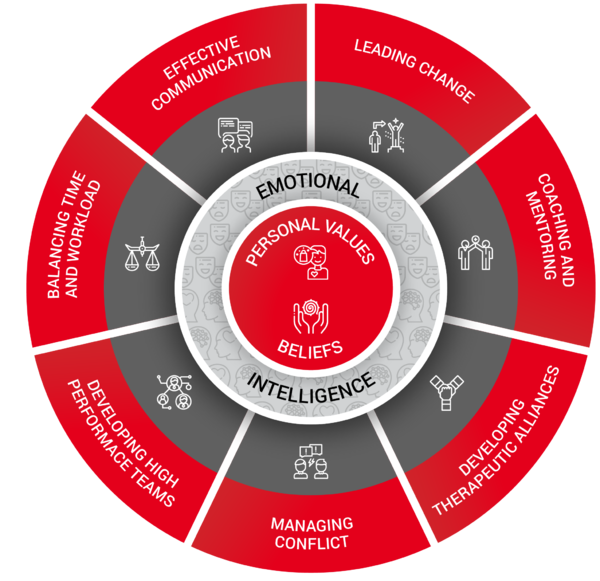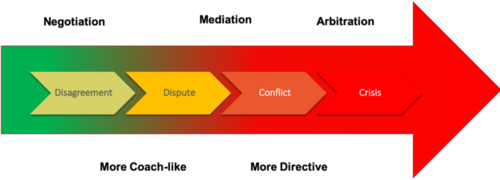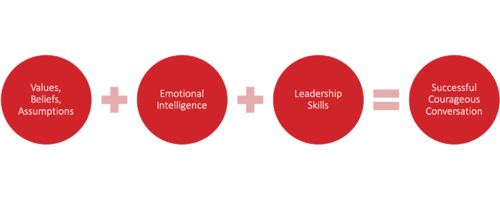Courageous Conversations
Introduction[edit | edit source]
A courageous conversations is thought of to be a discussion that is often difficult and uncomfortable. There are often emotions on both sides of the conversation and and can be awkward, stressful, or challenging situations. Usually the leader has an agenda or a desired outcome that needs to be achieved within the discussion. These outcomes may be a behaviour change, an action, or a change in attitude. The key is to be open, authentic, and honest while maintaining an atmosphere of trust and respect. Majority of people need to have a courageous conversation, find it most difficult to start the discussion off on the right foot or begin well.
The Rehab Leadership Framework[edit | edit source]
According to the Rehab Leadership Framework there are three layers to consider.
- Personal values and beliefs. These lie at the centre of the framework. They are fundamental to who we are as humans and influence how we approach leadership situations.
- Emotional intelligence. The next key aspect to our leadership effectiveness is emotional intelligence or the way in which we recognise, understand and manage emotions in order to develop or maintain social relationships and cope with challenges.
- Seven leadership skills. On the outer layer of this framework there are seven leadership skills that can be utilised to conduct and effective courageous conversation. These leadership skills are essential to effective leadership in rehab.
The Bar-On EQ-i model by Reuven Bar-On[edit | edit source]
The Bar-On model of emotional intelligence contains five main scales and 15 subscales.
5 main scales:
- Self perception
- Self expression
- Interpersonal
- Decision making
- Stress management
15 proposed subscales:
- Self-regard
- Self-actualisation
- Emotional self-assessment
- Emotional expression
- Assertiveness
- Independence
- Interpersonal relationships
- Empathy
- Social responsibility
- Problem solving
- Reality testing,
- Impulse control
- Flexibility
- Stress tolerance
- Optimism
Conflict Continuum[edit | edit source]
At one end we have disagreement, a difference of opinion. In this situation, the leader focuses on negotiation and compromise. Coaching the disagreeing parties to come to a win-win resolution. At times, this disagreement advances further and becomes a dispute. The leader shifts her approach becomes more of a mediator than a coach, trying to find common ground between the two opponents by asking questions and making suggestions. Now many conflicts are resolved at this stage and the two individuals find a way to move forward with an agreement. Yet at times the interaction heats up and becomes a full-blown conflict. As this happens, the leader shifts into an increasingly more directive and less coach-like approach. If things continue worsening the interaction shifts into a crisis situation. By now emotions are boiling over and the situation could become emotionally, psychologically, or physically unsafe. The leader becomes fully directive and may shift into a formal arbitration approach where each of the participants has representation. They may or may not be able to stay in the same physical space, and so on. The key message here is that as conflict advances or retreats, the leader must match his approach to the situation. Most times, once the interaction moves beyond dispute. A courageous conversation is unlikely to be effective. In fact, without a third party assisting with a discussion, a courageous conversation may actually worsen the situation and ignite additional frustration. So before you dive in, I suggest you pause, assess the situation and consider where things are at on the conflict continuum
Assessing the situation[edit | edit source]
Now in step one of this activity, think about a situation in your work or home life where a courageous conversation may be required. Describe that situation in the space provided.
Now in step two, identify where the situation would likely land on the conflict continuum with an X on the graphic provided. Then in step three, consider whether the situation is the right fit for a courageous conversation, or whether a different approach may be required. We want to be sure to match the right leadership approach to the situation. Okay. That's activity one, quick and easy.
Essentially our values, beliefs and assumptions, underpin who we are and how we show up in these challenging situations.
Our emotional intelligence or EI determines how we cope with the emotions that inevitably accompany these uncomfortable situations. And then, of course,
Our ability to skillfully navigate conflict, coach or mentor, and clearly communicate, dictate our actions and approaches to courageous discussions. Ultimately contributing to the outcome.
three phases of the courageous conversation journey are; first off, opening the conversation and then the interaction, and finally the resolution
Opening the conversation[edit | edit source]
1 - name the issue and select examples that illustrate the behaviour or situation that you want to change. If there are multiple issues to address, focus on the most important or the one or two that underpin the others. Now try to avoid general accusatory statements such as, "you always", or "you never". Focus on the behaviour in question, supported by an example.
2 - Next decision describe how the issue or behaviour has impacted you emotionally. Describe the impact in some detail so the other person has a clear picture of the results of their actions.
3 - Next, clarify what is at stake, and now in doing so your goal is to make sure that the other person understands why their behaviour and the impact of this behaviour matters to them, to you, to the team, to the patient or to others.
4 - Now, there are very few interactions between two people where the issue or concern is a hundred percent, one person's issue and zero percent the other person's issue. Often there's some shared responsibility. So let's describe that. What is your role in this situation or issue? How will you address your contribution to the problem? Whatever that is, describe it.
5 - Now, finally, at the end of your opening, double down on your commitment to finding a solution, describe any changes or contributions you intend to make to resolve the issue and open the conversational door for the other person to share their perspective.
Awareness Wheel[edit | edit source]
Now, one tool that you could use to guide the opening of a courageous conversation is the awareness wheel. Now the awareness wheel is a simple tool to help structure a challenging conversation, especially the opening. Now, when using the awareness wheel, we focus on using "I" statements and avoid using "you" statements. And thereby translate our internal experience into words so that other people can understand what's happening for us. we ask ourselves, what am I hearing or seeing? In other words, what am I observing with my five senses? Then we ask, what do I think? Or how am I interpreting what I'm observing with my five senses? Next we ask, what is my emotional response? Or how is my interpretation of this observation impacting me emotionally? And then, things get interesting as we ask, what do I truly want? Or what is the outcome or the result that I'm seeking? And finally we ask, what will I do, or what actions will I take to achieve the desired outcome? So that's the awareness wheel. A few simple questions to help us understand our unseen internal experiences and prepare for a successful opening of a courageous conversation.
Here's an example of an opening to a courageous conversation.
"Hi John. Thanks for meeting with me today. I wanted to take a couple of minutes to chat about a concern that I have. In the last three or four staff meetings, I've noticed you and Dan talking and laughing while I'm speaking. Now, although this may not be intentional, this behaviour is disrupting the team meeting and creating a distraction. Now, when this happens, I feel disrespected as though the information that I'm sharing is not meaningful or valued or important. Further, this behaviour impacts my ability to communicate, collaborate, and engage with our team, which erodes team cohesion and could lead to an unclear direction or a miscommunication within the group. Now, I also accept that I could be more succinct and focused in our team meeting. Now in my effort to improve going forward, I will provide our team with a more detailed agenda ahead of time, and commit to being focused and staying on schedule. Now I would like our team meetings to be productive, efficient, and engaging. With that, I'd like to understand the situation from your perspective. How do you see it? What's happening for you in our team meetings?"
Interaction phase[edit | edit source]
our focus is to listen, ask questions or inquire and clarify. Now, if the other person says something that you disagree with, resist the temptation to build a stronger case or react simply listen, ask questions, dig for deeper understanding, monitor, and manage your emotions, uncover assumptions. For example, try a mirroring technique by saying something like, "I hear you saying..." and repeat what they've said. "Do I have that right?" Please tell me more about this. I'd like to understand your thinking and how you came to that conclusion. Now, most times interaction may go on for some time as both parties ask questions and seek clarity.
Final phase[edit | edit source]
we move on to resolution. This is where the participants in the discussion come to an agreement on the next steps. Now, as the leader, you might consider asking questions such as. What have we learned in this discussion today? Where are we now? Has anything been left unsaid that needs saying? What is needed for resolution? How can we move forward from here given our new understanding? What have we committed to? How do we hold each other accountable?
When things don't go as planned[edit | edit source]
Refuses to admit there's a problem, accuses you of some wrongdoing, blames someone else for the issue or storms out of the room, or maybe reveals a serious personal problem? What should you do? Well, first off, stay calm, breathe, listen, ask questions, seek clarity. Attempt to diffuse the emotions within the situation by listening, showing empathy and encouraging discussion. The conversation may move further down the conflict continuum unexpectedly requiring you as the leader to shift your approach to one that is more directive or assertive. Now, it may be necessary to discontinue the discussion and regroup at another time or on a different day. It is important to consider the "what ifs" prior to launching into a discussion, so that when the discussion does go off the rails, you have a plan for that too. Now, ultimately managing your emotions, staying calm, seeking clarity, and ensuring the space remains safe are your primary responsibilities.
The Gibbs Reflective Cycle[edit | edit source]
is a simple tool that can guide you through the reflective process. Starting at the top of the cycle, describe your situation by asking yourself, what happened? Then reflect back on what you were thinking and or feeling during the interaction. Next, evaluate the situation by asking what was good or bad about the experience? Further, analyse the conversation by asking what sense can I make of this situation or interaction? Following the analysis, ask yourself, what else could I have done to achieve a better outcome? And finally, consider the question, if a similar situation arose, what would I do? The answers to these questions in this sequence will help you quickly reflect on the interaction, extract the learnings and prepare for the next time.










